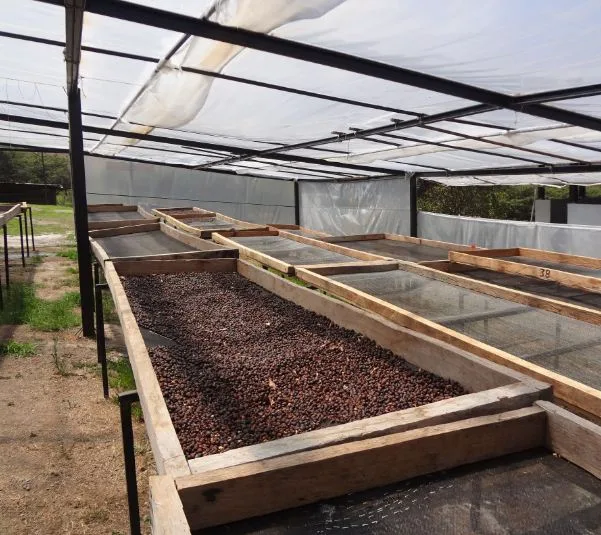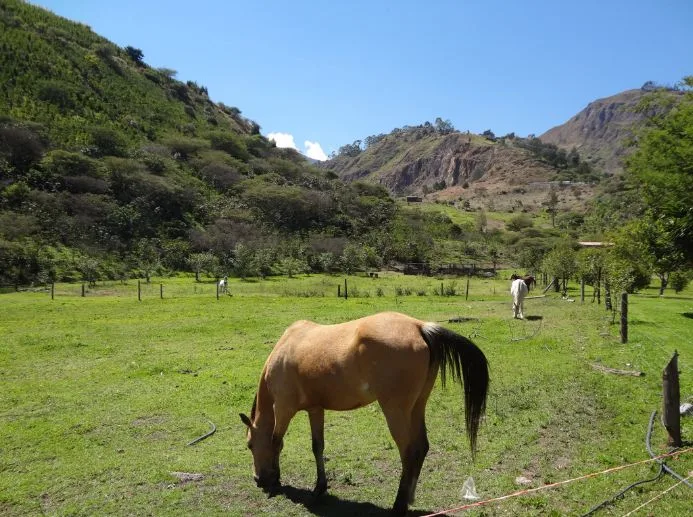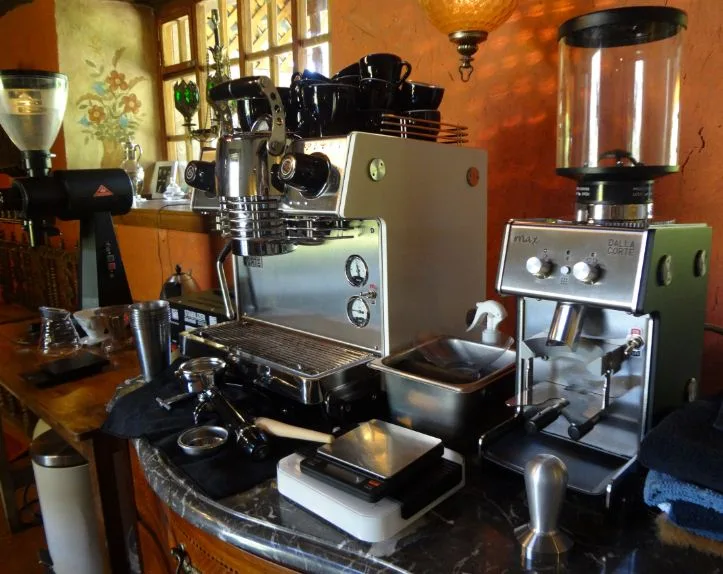Brewing great coffee: From crop to cup, the process of producing Ecuador’s best coffee never ends
By Sylvan Hardy
When Diego Mejía describes good coffee, his metaphors turn to fruits, flowers and spices.

Coffee partners Juan Peña and Diego Mejía at La Papaya.
“Can you taste the wild rose?” he asks a friend sampling the espresso he just served. “Maybe there’s a hint of cinnamon as well, no?”
Mejía, who was named Ecuador’s champion barista at the annual competition in Guayaquil in August, is passionate about coffee flavors as well as describing how they were created in the growing, drying and roasting processes. “There’s a reason for every taste and the best coffee growers and roasters understand this and work very hard to achieve it,” he says.
In June, when Mejía heads to the world barista championships in Amsterdam, he will take with him coffee beans from Hacienda La Papaya, near Saraguro. After sampling the produce from most of the coffee growers in Ecuador, he says the beans from La Papaya are the best. “Juan understands that every step of coffee production is important, from the crop to the cup,” says Mejía, referring to the La Papaya owner Juan Peña.
“He’s the scientist,” says Mejía. “He’s the guy who knows all about the plants, the weather, the chemistry — everything there is to know — about growing good coffee. His beans are some of the best in Latin America and remind me of coffee from Kenya and Ethiopia,” he says.

The office at La Papaya.
Peña, who divides his time between Cuenca and La Papaya, is, in fact, a scientist, holding degrees in agronomy and chemistry. “Each step in the growing and production of coffee is crucial to the final product,” he says. “There’s the variety of coffee you choose in the first place and then, the quality of the particular beans, the soil type, fertilization, moisture levels, growing conditions such as the amount sunlight the plants receive.”
According to Peña, producing good coffee beans is an endless challenge. “Many growers work hard to get a good crop but then they decide they will do the same thing the next year,” he says. “But there are so many variables in the process you can’t relax. What works one year may not work the next because of weather and other conditions.”

Coffee beans drying
Peña adds: “For me, it’s not just about maintaining the high quality, but of continuing to improve it, year after year. If I can’t make the product better and better, there’s no challenge and no fun.”
At the various work stations at La Papaya, from the nursery for seedlings, to the drying and roasting areas, Peña keeps detailed notes on clipboards. There are daily reports on hours of sunshine, humidity and temperature. A secretary in the office compiles the data that is then converted into charts and graphs for Peña and his workers to review.
The amount of coffee produced at La Papaya is relatively small, but this is fine with Peña. “With smaller crops you can spend more time on important details,” he says. Most of the hacienda’s beans are sold at top price to boutique roasters and distributors in the U.S. and South Korea.
Hacienda La Papaya
According to Peña and Mejía, La Papaya is perfect for coffee growing. An original Spanish land grant in the early 1600s, the hacienda sits in a picturesque valley at an elevation of 6,300 feet and enjoys distinct dry and rainy seasons. Although it’s located in Loja Province and can only be accessed through the town of Saragura, it’s only a few hundred meters south of the Azuay Province border, and has a clear view of Santa Isabel in the Yunguilla Valley.

Horses graze at La Papaya next to the coffee trees.
“It’s a beautiful spot with great weather year-round,” says Peña and the elevation is ideal given our proximity to the equator.” He and Mejía are planning coffee tours to La Papaya, which has several guest rooms, sometime in 2018. “For people who are interested, we would like them see the entire coffee growing process, from the seedlings to finished product.”
The barista at work
Watching Mejía prepare coffee, whether it’s a simple cup of tinto or a cappuccino or espresso, is sheer pleasure. He prepares it on high-end equipment that he and Peña had shipped in from Europe and the U.S., expertly describing each step of the process. Once it’s served, the discussion turns from the preparation process to the taste.

The equipment
“This is what baristas do,” Mejía says, laughing. “We talk a lot but mostly we want to know what you think of our coffee.”
Mejía will be preparing a lot of coffee in the coming year. He and Peña are renovating a store near Parque Calderon in Cuenca for a coffee shop they hope to open in February. Mejía says stay tuned for details.
For those who want a preview of the final product, Mejía and Peña are hosting a coffee-making and tasting session Saturday morning from 9 a.m. until 1 p.m.at Santa Canela Bar and Grill on Calle Larga. Cost is $10 per person. To sign up, write Diego at diegol_m4@hotmail.com




















